Before and After: Historic Landmarks Throughout Time
From the iconic Washington Monument to the unforgettable Eiffel Tower, these beloved landmarks were once unrecognizable. It’s hard to imagine our world without them!
Take a look at the following comparison photos that really demonstrate how much our world has changed and developed over time – Let us take a moment to appreciate just how magnificent these incredible sights truly are.
Lincoln Memorial, Washington DC
In 1917, the Lincoln Memorial was still under construction. Despite the lack of greenery, the site was a magnificent sight to behold. The giant marble-clad structure was a testament to the spirit of Abraham Lincoln and the people of the United States.

Source: National Photo Company Collection/Wikimedia Commons | Carol M. Highsmith/Buyenlarge/Getty Images
Even though the finishing touches were yet to be applied, it was clear that the memorial was going to be something truly special. Five years later, the monument was finally dedicated and opened its doors to the public. It has since become a symbol of national pride and an ode to the legacy of Abraham Lincoln.
Brandenburg Gate, Berlin, Germany
This remarkable photo captures the Brandenburg Gate in a unique before and after display. In 1945 the Gate was in a state of disrepair, shattered after the Allies defeated Germany and was occupied by the Soviet Union.

Source: Central Press/Hulton Archive/Getty Images | Sean Gallup/Getty Images
But today, the Gate stands as a symbol of Germany’s resilience and recovery, restored to its original grandeur after 70 years. It is a reminder of how far the nation has come and the hope of continued progress and prosperity.
Pablo Escobar’s plane, Bahamas
The infamous Colombian drug kingpin Pablo Escobar owned a plane, which was used to smuggle narcotics. In 1980, the aircraft crashed while attempting to land at an airstrip on Norman’s Cay in the Bahamas.

Source: DALLMYD/YouTube
35 years later, the plane remains in an advanced state of decay. Escobar’s reign was formidable, however his life ended in a shootout in 1993. It is a stark reminder that all powerful figures eventually meet their end.
Golden Gate Bridge, San Francisco
It’s hard to imagine this landscape without it! Who would have thought that the breathtaking view of San Francisco’s Golden Gate Bridge was once something that didn’t exist? Merely a thought that had yet to be created.

Source: Shepp, James W.; Shepp, Daniel B./Shepp's Photographs of the World/Wikimedia Commons | Rich Niewiroski Jr.
The left image from 1891 shows us exactly that – the exact location, without the iconic landmark. Fast forward to 1937, and the 746-foot towers were erected, creating one of the most recognizable sights in the world. It’s incredible to think that this beautiful view once looked so different.
Harpers Ferry train, Maryland/West Virginia
In the 1940s, the “Columbian”, a passenger train, operated by the Baltimore and Ohio Railroad was the epitome of luxury travel. This iconic train is seen in 1949 crossing the Potomac River, gracefully gliding towards Harpers Ferry in West Virginia.

Source: JGHowes/Wikimedia Commons | Piedmont District Railfan/YouTube
Fast forward to 2021, Amtrak took over the route and continues to get passengers to Harpers Ferry National Historical Park. While the modern train may lack the glamour of its predecessor, it is still a great way to experience a scenic journey.
Forth Rail Bridge, Scotland
The Forth Bridge stands as a remarkable feat of engineering and a symbol of Scotland. Its red steel structure’s have been a landmark of the area since its completion in 1890 and continue to this day, providing a vital link between Edinburgh and the north of Scotland.

Source: Philip Phillips/National Library of Scotland/Wikimedia Commons | andrum99/Forth Bridge/Wikimedia Commons
This iconic structure serves as a reminder of Scotland’s proud history of construction and innovation. The image on the left depicting the partially completed bridge in 1887, shows us just how much can change in the span of 2 years!
Hiroshima, Japan
On August 6th, 1945, tragedy befell the city of Hiroshima, Japan. An atomic bomb was dropped, leaving the city in ruins and eighty thousand people dead. However, the people of Hiroshima were resilient, and the city slowly began to rebuild. Today, Hiroshima stands as a modern metropolis.

Source: U.S. Navy Public Affairs Resources Website/Wikimedia Commons | U.S. Department of State/Wikimedia Commons
Against all odds, a new Hiroshima has risen from the ashes of the old, proving that the human spirit can overcome even the most impossible of circumstances. This city is a powerful reminder of the strength and perseverance of humankind.
Las Vegas, Nevada
Since the 1940s, Las Vegas has been the ultimate destination for thrill-seekers, both American and international. Bright neon lights, daring casinos and 8 million annual visitors by 1954 helped garner the city’s reputation as the go-to destination for a good time.

Source: GE Kidder Smith/Corbis/VCG via Getty Images | PhotoQuest/Getty Images
Now, more than 40 million people flock to the city every year, eager to experience its unique atmosphere and take part in its famous nightlife. With no shortage of brass and bravado, it’s no wonder Las Vegas has been an inimitable playground for decades.
Great St. Martin Church, Cologne, Germany
The two images of St. Martin’s Church in Cologne, Germany, show its remarkable transformation over a 64-year period. In 1946, the church was a sight of destruction, with Allied air forces having bombed the city during World War II.
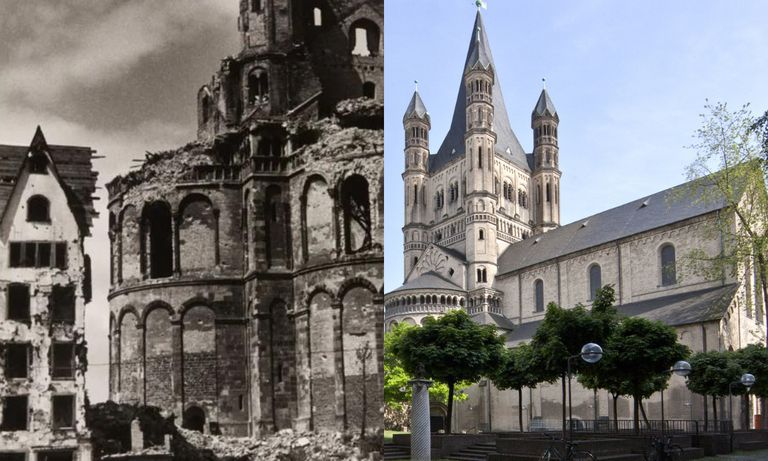
Source: Wikimedia Commons | Hpschaefer/Wikimedia Commons
Decades of hard work and dedication, spanning through the 1950’s to the 1980’s, and finally the magnificent architectural sight was restored to its former glory. The church was once again open to worshippers, just as it had been since medieval times.
Statue of Liberty, Paris and New York City
Glimpse a unique perspective of the Statue of Liberty! This incredible image of Lady Liberty’s head was taken all the way back in 1883, when she wasn’t even in America yet. Artist Frédéric-Auguste Bartholdi was still creating her in Paris at the time.

Source: Albert Fernique/Wikimedia Commons | Gary Hershorn/Getty Images
Fast forward to 2021, and the statue can be seen in the backdrop of the Empire State Building, lit up to celebrate Veterans’ Day. Since being designated as a UNESCO World Heritage site in 1984, the Statue of Liberty has welcomed an incredible 3.5 million visitors annually.
Eiffel Tower, Paris, France
Upon first glance you mightnt recognise the magnificence of the Eiffel Tower in the picture on the left, but after closer inspection you can see that it is indeed the Eiffel Tower in the process of being built in Paris. On the right, the completed iconic structure is illuminated in all its beauty.

Source: Bettman/Getty Images | Antoine Antoniol/Getty Images
From the chaotic scaffolding of the early stages of construction to its fully illuminated presence today, the Eiffel Tower is an awe-inspiring reminder of how far we can go when we set our minds to something. This iconic monument is a testament to the ingenuity and ambition of mankind.
La Sagrada Familia, Barcelona, Spain
The magnificent La Sagrada Familia has been a Spanish icon since 1882, when the visionary Antoni Gaudi began to create his masterpiece. Fast forward to 2020, and the cranes have still not left the skyline – a testament to Gaudi’s prediction that it could take two centuries to finish the monumental Roman-Catholic cathedral.

Source: Baldomero Gili Roig/Museu d'Art Jaume Morera/Wikimedia Commons | David Ramos/Getty Images
The 1905 image on the left captures the moment in history, when the immense structure was already well underway, yet far from finished. To this day, it remains one of the world’s most ambitious engineering projects, long after Gaudi himself passed away.
Mount Rushmore, South Dakota
The Black Hills of South Dakota were transformed in 1936, when the iconic faces of four US presidents were revealed atop Mount Rushmore. After 14 years of hard work and dedication, the Mount Rushmore National Memorial was unveiled, showcasing four presidents carved into a granite cliff face.

Source: National Park Service/Wikimedia Commons | Harold M. Lambert/Getty Images
Abraham Lincoln, Theodore Roosevelt, Thomas Jefferson and George Washington, each immortalized for generations to come. A testament to the artistic skill of the sculptor, Gutzon Borglum, and the vision of a nation, Rushmore stands as one of the most iconic landmarks in North America.
Machu Picchu, Peru
Hiram Bingham III, an American explorer, first revealed the magnificence of Machu Picchu to the world in 1911. The first image he captured in 1912 shows the beginning stages of the incredible Inca citadel in Peru being cleared. Today, the same site appears much different due to extensive excavation.

Source: Hiram Bingham III/Wikimedia Commons | DEA/G. DAGLI ORTI/De Agostini via Getty Images
According to Britannica, Machu Picchu was likely a palace complex of the ruler Pachacuti Inca Yupanqui, who reigned from 1438 to 1471. His vision of this majestic sanctuary lives on in the captivating views it offers today.
Great Wall of China
The Great Wall of China has been standing for centuries – and it’s no wonder why! This incredible structure has been a witness to the ages, first built in 7th century B.C. Over the centuries it has been added to and maintained.
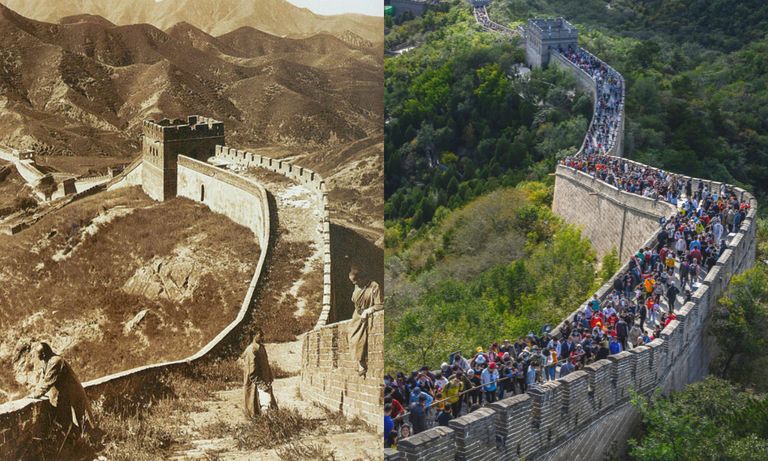
Source: Herbert G. Ponting/Wikimedia Commons | Kevin Frayer/Getty Images
It is no surprise that today it remains a favorite tourist destination, with hoards of people flocking to its base which is over 20 feet wide. This breathtaking structure is a reminder of an incredible history and allows up to step back in time.
Arc de Triomphe, Paris, France
The transformation of the Tour de France is truly remarkable! Look at the difference between the riders in 1926 and today: hats, ties and coats versus modern lycra uniforms. Back then, they had to rely on a train to take them to the starting point of the race in Evian.

Source: Maurice-Louis Branger/Roger Viollet via Getty Images | Chris Graythen/Getty Images
Now, they can be seen flying down the Champs-Élysées, with the iconic Arc de Triomphe as a backdrop. The grand finale of this 21 stage race has been a dramatic spectacle for Paris since 1975. It’s a testament to the incredible progress of the Tour de France, it truly has withstood the test of time!
Flatiron Building, New York City
The iconic Flatiron Building in New York City is instantly recognizable. The image on the left depicst the partially constructed bulding in 1902. As of today this iconic landmark stands at 307 feet tall with 22 floors, as seen in the righthand picture, this marvellous building in all its glory!

Source: Detroit Publishing Company/Interim Archives/Getty Images | Santi Visalli/Getty Images
Many believe the building earned its name from its unique triangular shape. In reality, the plot upon which it stands was known as “the Flat Iron” long before the building was built. A symbol of New York City’s architectural history, it is an iconic and beloved landmark throughout the world.
Leaning Tower of Pisa, Italy
The iconic Leaning Tower of Pisa has been photographed millions of times! Take a look at these side-by-side shots of the same pose, spanning a whopping 65 years! On the left, a U.S. Navy sailor from Chicago, Illinois, Robert Bradford, posed in 1948. And on the right, a tourist in 2013.

Source: Bettman/Getty Images | Barney Moss/Flickr
The 186-foot tower was built in 1173 and began to lean just five years into the building process. However, the latest news suggest that the tower is now slowly straightening up, according to the BBC. Both ways we are sure this iconic landmark will be in tourists photos for decades to come.
Grand Central Depot and Terminal, New York City
At first glance, this seemingly ordinary structure, depicted on the left, was nothing more than a simple skeleton, but it was destined for greatness. In 1871, the first station was opened on the site, and it marked the beginning of the now iconic Grand Central Depot in Manhattan.

Source: Museum of the City of New York/Getty Images | Andrew Burton/Getty Images
Over the years, the site has been home to three different railway stations, culminating in today’s Grand Central Terminal. With its famous clock, vaulted ceilings, and hustle and bustle, it’s no wonder the station has become an iconic landmark.
Sloane Street, London, England
Sloane Street in London has been a witness to history. In 2014, it marked the 100th anniversary of the outbreak of World War. But back in 1918, the street had a much different look as it was adorned by the presence of American troops parading through.
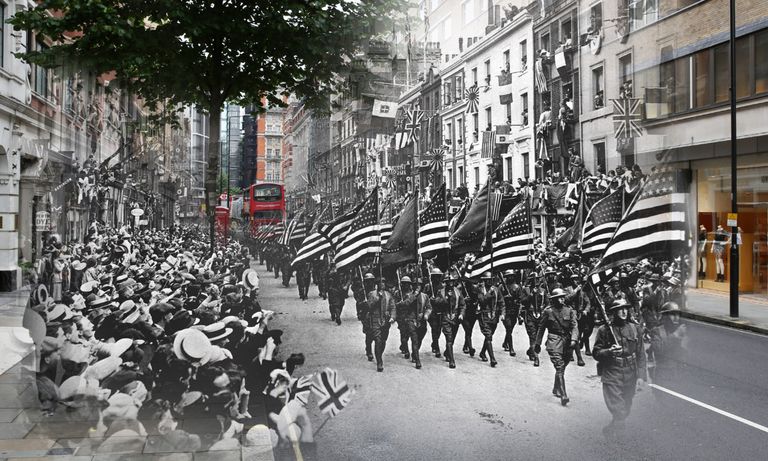
Source: Interim Archives/Getty Images | Peter Macdiarmid/Getty Images
The older portion of the image shows the soldiers that had sailed across the Atlantic to join the fight against Germany in the trenches of Europe. An iconic reminder of the great sacrifices made for a greater cause.
The Alamo, Texas
The Alamo is a powerful symbol of American history and freedom. In 1836, Davy Crockett, James Bowie, and their comrades died when bravely defending the site against Mexican soldiers in a fight for freedom.

Source: unattributed/Cowan's Auctions | BrendaAly/Wikimedia Commons
Although the Alamo was neglected in the 1860s, it has since been restored and is now a memorial to those who fought and died there. Americans recognize it as a symbol of resistance to oppression and a reminder of the courage and determination of those who stood up for their beliefs.
Dresden, Germany
In early 1945, Allied forces rained down upon the city of Dresden, 800 planes dropping approximately 2,700 tons of bombs. This strategic transport hub was almost completely flattened, resulting in an estimated 25,000 lives lost.

Source: William Vandivert/The LIFE Picture Collection/Getty Images | Sean Gallup/Getty Images
The 18th-century Frauenkirche church, renowned for its intricate Baroque architecture, was also destroyed. But in the 1990s, reconstruction of the church began and by 2005, the Frauenkirche church was brought back to its former glory, standing as a somber reminder of the tragedy that befell the world.
Panama Canal
For more than a century, the Panama Canal has been a marvel of engineering, connecting the two largest oceans on Earth. In 1903, a daring vision began to take shape, and 5 years later this photo was taken as a testament to the progress made.

Source: H.C. White Co./Wikimedia Commons | Paul Harrison/Wikimedia Commons
Today, more than 13,000 vessels pass through the canal annually, with the locks raising them an incredible 85 feet above sea level. It takes 8-10 hours to negotiate the 40-mile waterway, allowing the transportation of an astonishing 255 million tons of cargo. The Panama Canal is an epic feat that continues to astound the world.
Moulin Rouge, Paris, France
It’s 1895 and a shot of the Moulin Rouge has been taken photographed. This legendary nightclub, translating to “red mill” in French, where artist Toulouse Lautrec painted his celebrated works highlighting life at the club.

Source: LL/Roger Viollet via Getty Images | Colin Davey/Getty Images
Fast forward almost 120 years later and it still stands strong today! There’s no doubt that visitors can expect an evening full of show-stopping feathers, sequins and rhinestones when they step inside its walls.
Empire State Building, New York City
The iconic Empire State Building was completed in 1931, standing 1,250 feet high, making it the world’s tallest building for an incredible four decades. Its construction was an incredible feat of engineering and it remains a symbol of New York and the USA.

Source: Nationaal Archief/Wikimedia Commons | Gary Hershorn/Getty Images
Today, it stands tall amidst the modern Manhattan skyline, with tourists flocking to the viewing platform on the 102nd floor. From here, you can admire the breathtaking views of the city and beyond. It’s no surprise that the Empire State Building continues to draw in the crowds and inspire awe in all who visit.
Tower Bridge, London, England
Tower Bridge, spanning the majestic Thames river right next to the Tower of London, is a magnificent sight. With its iconic Victorian Gothic style architecture, it has become an integral part of London’s skyline. This 1892 image shows us that even when partially completed it was already a marvel.

Source: ChrisO/Wikimedia Commons | Mike Kemp/In Pictures via Getty Images
Today this bridge is still heavily used by traffic traveling across the river and impressively raises up to 800 times each year for marine vessels! Even after 130 years between when these images were taken you can still see how much this bridge adds to the London cityscape.
Stonehenge, England
This remarkable 1885 photograph of Stonehenge in Wiltshire, England, captures a moment in time 5,000 years after the monument’s original construction. If you compare it to a modern photograph, you’ll notice that the stones have been rearranged over the years.

Source: unsigned/Wikimedia Commons | Tim Ockenden - PA Images/PA Images via Getty Images
But what was Stonehenge’s original purpose? English Heritage suggests it may have been a Druid temple, an astronomical computer, a cult centre for healing, or most likely a prehistoric temple aligned with the Sun’s movements. It remains an unsolved mystery, as fascinating today as it was in 1885.
Parthenon, Athens, Greece
The Parthenon stands tall and proud, yet aged and worn, atop a hilltop in Athens in the lefthand image from 1850. Built 2,500 years ago, this majestic temple has weathered wars, earthquakes and lootings, but still stands for the powerful symbol of Greek civilization it has long been.

Source: Miscellaneous Items in High Demand, PPOC, Library of Congress/Wikimedia Commons | Nikolas Kokovlis/NurPhoto via Getty Images
In more recent time, the ruins of this great temple have been carefully restored in order to return it to its former glory, making it a must-see destination for visitors from all around the world. Let us admire the Parthenon, a testament to the resilience of Greek culture.
Eilean Donan Castle, Scotland
A century ago, Eilean Donan Castle was reduced to ruins. But thanks to the dedication of Lieutenant Colonel John Macrae-Gilstrap, this majestic 13th-century castle has been restored to its former glory. The side-by-side shots show the incredible transformation of this picturesque castle, perched on a small island at the conjunction of three sea lochs.

Source: G. W. Wilson & Co./Wikimedia Commons | David Cannon/Getty Images
The early-20th century image reveals a damaged ruin, while the 21st-century photo reveals a beautifully restored castle, standing tall and proud. It’s a testament to Macrae-Gilstrap’s hard work, having spent two decades restoring the beloved castle.
Horse Guards Parade, London, England
This striking image captures Horse Guards Parade, near Buckingham Palace, as it appeared in 1915 and 2014. This image captures a powerful contrast between the past and the present. Depicting the evolution of the nation in on glance.
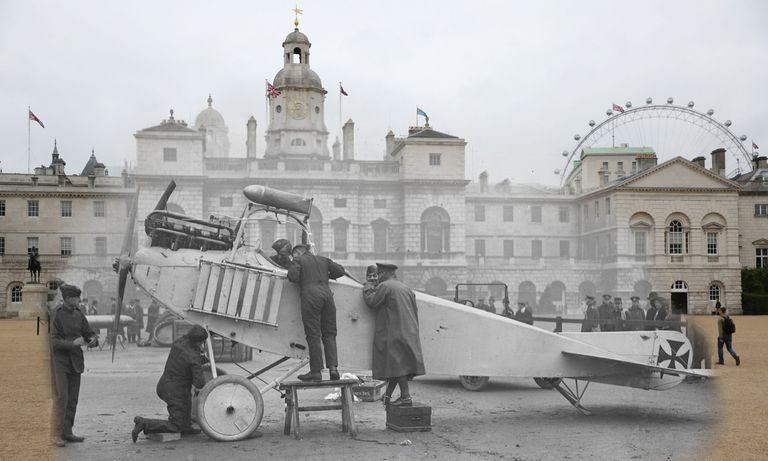
Source: Topical Press Agency/Getty Images | Peter Macdiarmid/Getty Images
On the left, Horse Guards Parade in 1915 is filled with the solemn presence of British troops inspecting a German plane captured during WWI. On the right, the same landscape is transformed, with the iconic London Eye providing a delightful backdrop. It’s a vivid reminder of the evolution of the nation over the last century.
Woodstock, New York State
The summer of ’69 was an unforgettable one. It was the peak of the hippie era and it saw the iconic Woodstock Festival take place in a rural town of New York State. Hundreds of thousands of attendees flocked to the fields, eager to ‘turn on, tune in, and drop out’.

Source: Clayton Call/Redferns via Getty Images | u/spkelly37/Reddit
But now, fifty years later, the same fields have returned to their peaceful and rustic past. No longer are they filled with the energy and excitement of the fans awaiting legendary performers like Jimi Hendrix, Jefferson Airplane, and the Grateful Dead. Instead, their presence is merely a distant memory.
Lombard Street, San Francisco
The iconic Lombard Street in San Francisco is renowned for its dizzying switchback curves. This famous street in the Russian Hill district is the world’s most crooked street, with its eight hairpin turns, featuring a maximum speed limit of just 5mph.

Source: UPI/Bettmann Archive via Getty Images | Gabrielle Lurie/San Francisco Chronicle via Getty Images
This photo, taken in 1954, shows the famous road, while the 2019 photo gives a greater sense as to just how steep it really is and of how the area has changed over the decades. Designed in 1922, this route was deemed too steep for both cars and pedestrians. It’s no wonder Lombard Street remains a popular tourist destination to this day!
Washington Monument, Washington DC
From its humble beginnings as a tiny structure that looked like it was in the middle of nowhere, the Washington Monument grew to become an iconic part of the DC skyline. What started as a mere stub in 1848, eventually rose to a breathtaking 555 feet in 1884.

Source: Mathew Benjamin Brady/Wikimedia Commons | Brendan Hoffman/Getty Images for (RED)
Despite delays from a lack of funds, technical issues and the Civil War, the monument stands tall to this day as a symbol of America’s independence. Once used as a cattle yard during the Civil War, the Momument is now an iconic destination.
Mont-Saint-Michel, France
The majestic Mont-Saint-Michel, located off the coast of Normandy, France, is a sight to behold. Dating back to the Middle Ages, this impressive tidal isle has endured many sieges from the English during the 100 Years War.

Source: Print Collector/Getty Images | Jeff Morgan/PhotoPlus Magazine/Future via Getty Images
This modern image captures the magnificent beauty of the island’s buildings, taken in a stunning fall 2011 sunrise. From its ancient fortifications, to its elegant grace, Mont-Saint-Michel is a true marvel of history.
Gateway Arch, St. Louis
The Gateway Arch in St. Louis, Missouri stands tall as a reminder of the city’s past and its place in American history. The 630-foot stainless steel structure is an iconic symbol of the city, standing at the entrance to the Mississippi River and welcoming visitors to the Gateway City.
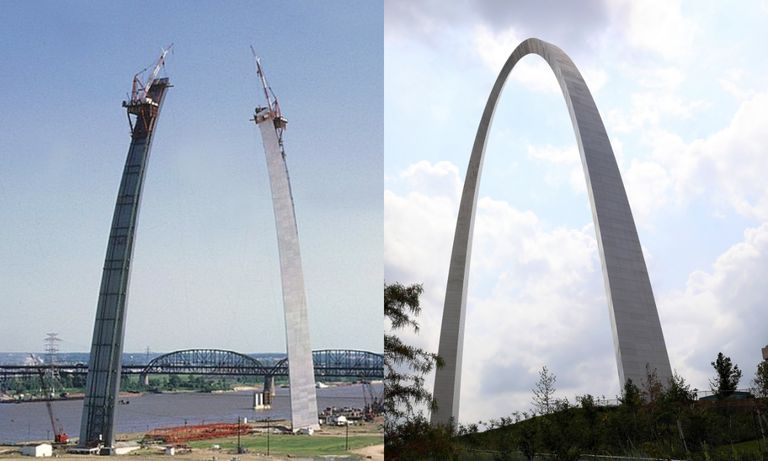
Source: Kevin William Kelly/Wikimedia Commons | Raymond Boyd/Getty Images
It is the world’s tallest arch and a national monument, attracting millions of visitors each year. Visitors can even take a ride up for some stunning views. Built between 1963 and 1965, the arch celebrates the westward expansion of the United States.
Trinity Church, Boston
Trinity Church, Boston is a historic landmark that has been a part of the city’s history for centuries. The church has been a place of worship and comfort for generations. The lefthand image, from 1735, depicts a very different Trinity Church, before a 1872 fire destroyed it. The community decided to rebuild and relocate the church.

Source: Trinity_Church,_Summer_St..jpg/Wikimedia Commons | Paul Marotta/Getty Images
The new Trinity Church designed by architect Henry Richardson, as shown in the righthand image, got quite a makeover. The imposing red-brick building stands out among the city’s modern architecture, featuring beautiful stained glass windows, a magnificent altar, and exquisite artwork.
Fort Sumter, Charleston
Fort Sumter stands as a powerful reminder of America’s past. In 1861, the first shots of the Civil War were fired at the fort, located in Charleston, South Carolina. Nearly two years later, the Union’s navy bombarded the fort, leaving it damaged and in ruins.

Source: Francis Trevelyan Miller/Wikimedia Commons | National Park Service Digital Image Archives/Wikimedia Commons
Despite this, Fort Sumter has survived and is now a National Monument, standing as a poignant reminder of the internecine conflict that once tore apart the nation. Today, visitors can take a ferry to tour the island and explore the preserved ruins of the fort. It’s a powerful reminder of the past and of how far the nation has come since.
Walt Disney Concert Hall, Los Angeles
This futuristic building is no ordinary construction! The Walt Disney Concert Hall in Los Angeles is a unique creation by renowned architect Frank Gehry. It boasts an eye-catching, sci-fi look and is home to the Los Angeles Philharmonic.

Source: Cygnusloop99/Wikimedia Commons | Frazer Harrison/Getty Images for LAPA
But the hall is far from just a venue for classical music – visitors can enjoy a range of musical events from world music to jazz. In 2001, the building was still under construction and resembled a kid’s construction kit, yet today it stands as a captivating cascade of steel waves.
Pripyat, Ukraine
Pripyat, a Ukrainian city, was built in the 1970s for the staff of the Chernobyl nuclear power station. Unfortunately, in 1986 it experienced an unimaginable disaster when the power station suffered a catastrophic meltdown.

Source: Sean Gallup/Getty Images
This photograph captures the Energetik cultural center in the foreground as it was before the city was evacuated, with the current state of the building in the background – a bleak reminder of the nuclear accident. Pripyat, a city that was once full of life, now stands as a haunting reminder of the power of nuclear energy.
Brooklyn Bridge, New York City
The iconic Brooklyn Bridge stands majestically over the East River, connecting Brooklyn to Manhattan. For over a century, it has been a symbol of strength and resilience, a link between two boroughs and a reminder of the great engineering feats of the 19th century.

Source: Brooklyn Museum/Wikimedia Commons | Suiseiseki/Wikimedia Commons
On its opening day it is said 150,000 people crossed it to bare witness to this incredible achievement. To prove that it could carry even more weight than expected, P.T. Barnum marched 21 elephants across it in 1884! Today the bridge stands tall over the East River as a testament to America’s engineering genius – a reminder of how far we have come since then.
